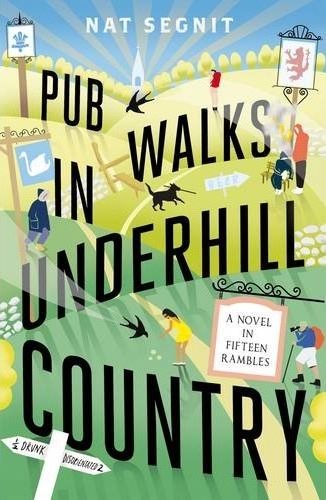Pub Walks in Underhill Country:
A novel in fifteen rambles
by Nat SegnitPub walks in Underhill Country is both Nat Segnit’s first novel and probably one of the first novels to take the form of a series of guided walks.

Graham Underhill, a middle-aged council official, watercolourist and author of a series of self-published walking guides, narrates the tale. He is what Lemon Jelly might refer to as a ‘Rambling Man’: his idea of a good time largely consists of assembling a ‘ramblesack’ of an array of personal protective equipment and fortifying snacks and setting off for the hills. In Pub walks in Underhill country, Underhill introduces us - through fifteen guided walks - to his first love, his local landscape (centred on Ledbury, a market town in rural Herefordshire) and to his second, his wife, Sunita.
The eponymous Underhill might be considered a rambler in more than one sense of the word. His rambling delivery of the fifteen guided walks that comprise this novel simultaneously rambles across the physical landscape and his internal, mental one, noting points of interest along the way. In the process we follow Underhill on a quest to keep hold of his relationship with the beautiful and exotic Sunita, his distant second wife, whilst simultaneously trying to save the house that his father built from the threat of a Hitch Hikers Guide to the Galaxy-esque destruction-by-bypass.
Despite being his first novel, this is not Segnit’s first foray into comedic writing. In addition to his journalistic contributions to various national newspapers and magazines, the Londoner has also written a comic play (Dolphin Therapy) and two comedy series (Strangers on Trains and Beautiful Dreamers), each of which has been broadcast on BBC Radio 4.
Although writing a novel in the form of a series of guided walks is undeniably an ingenious premise, and whilst Segnit’s execution of it is undoubtedly adept, it can feel a little tiresome. Just as soon as we’re getting to a particularly juicy bit about Underhill’s personal life, the prose abruptly segues into walking directions, tasting notes on a particularly fine ale or a review of some form of hostelry. Indeed, if this novel is transformed into a TV or radio series, one would hope Segnit receives sponsorship from CAMRA or perhaps links up with fancyapint.com.
At times the sub-plot concerning Underhill’s relationship with Sunita seems glaringly obvious – to all but Underhill, in fact – but cleverly, Segnit manages to keep a few surprises in store.
Segnit rather shows off how well-read he is, interspersing quotes from and references to literary greats such as William Wordsworth, Rhodri Thomas and Jorge Luis Borges amongst various geographical and natural historical observations relating to the areas around which we ramble with Underhill. What’s particularly nice about these walking guides is their references to the kinds of life that tends to be left out of your real-world equivalent guide: Underhill suggests tactics to slip past the groups of hooded youths that may congregate at parts of the route with only a minimal peppering of insults; he identifies areas prone to dogging, which the rambler might prefer to pass quickly through; and includes paintings of the kinds of discarded toilet seats the rambler may well spot when following the route. The pictures dotted throughout the book, ostensibly produced by Underhill (although Segnit should perhaps properly be credited) are a nice touch and lighten what can at times be heavy reading.
In Underhill’s character, Segnit succinctly captures the best and worst personality quirks associated with those who like to spend their time rambling: from an appreciation of the natural world and our cultural heritage to a fixation with the ‘wrong’ kind of people with the ‘wrong’ kind of equipment to go walking in. Whilst it’s hard not to empathise with Underhill, the reader can’t help feeling a bit like he can be a right priggish snob. Impressively, although we predominantly get to know Sunita through Underhill’s rose-tinted spectacles, she is still a thoroughly dislikeable character and it’s hard not to feel sorry for Underhill, and quite impressed at his tolerance.
The rambling prose and factual bombardment might not make this book ideal for impatient readers or for those with a low tolerance for non-fiction. It’s certainly not laugh-out-loud funny but it does showcase the author’s appealingly wry sense of humour. We can think of worse ways to spend a weekend than attempting a ramble through Underhill country, and have worked up quite a thirst to discover how Segnit might attempt to top such an original idea in his second offering.
